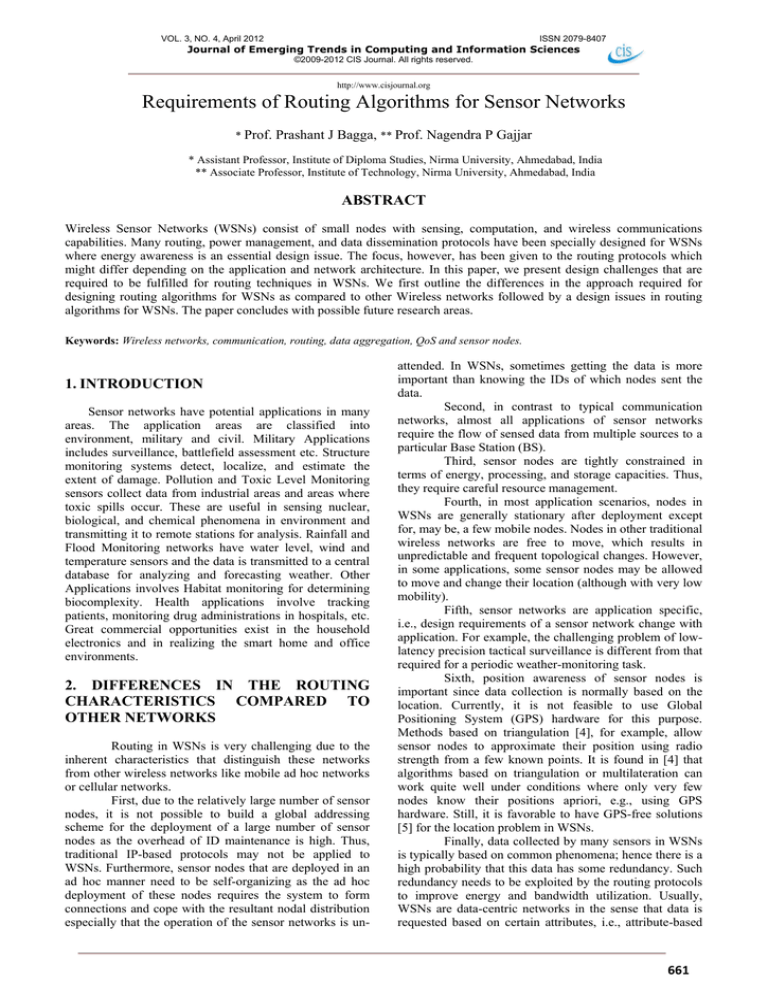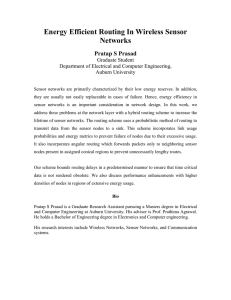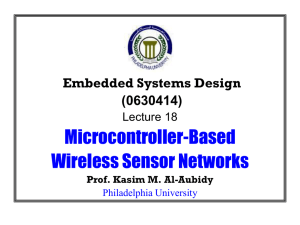
VOL. 3, NO. 4, April 2012
ISSN 2079-8407
Journal of Emerging Trends in Computing and Information Sciences
©2009-2012 CIS Journal. All rights reserved.
http://www.cisjournal.org
Requirements of Routing Algorithms for Sensor Networks
* Prof.
Prashant J Bagga, ** Prof. Nagendra P Gajjar
* Assistant Professor, Institute of Diploma Studies, Nirma University, Ahmedabad, India
** Associate Professor, Institute of Technology, Nirma University, Ahmedabad, India
ABSTRACT
Wireless Sensor Networks (WSNs) consist of small nodes with sensing, computation, and wireless communications
capabilities. Many routing, power management, and data dissemination protocols have been specially designed for WSNs
where energy awareness is an essential design issue. The focus, however, has been given to the routing protocols which
might differ depending on the application and network architecture. In this paper, we present design challenges that are
required to be fulfilled for routing techniques in WSNs. We first outline the differences in the approach required for
designing routing algorithms for WSNs as compared to other Wireless networks followed by a design issues in routing
algorithms for WSNs. The paper concludes with possible future research areas.
Keywords: Wireless networks, communication, routing, data aggregation, QoS and sensor nodes.
1. INTRODUCTION
Sensor networks have potential applications in many
areas. The application areas are classified into
environment, military and civil. Military Applications
includes surveillance, battlefield assessment etc. Structure
monitoring systems detect, localize, and estimate the
extent of damage. Pollution and Toxic Level Monitoring
sensors collect data from industrial areas and areas where
toxic spills occur. These are useful in sensing nuclear,
biological, and chemical phenomena in environment and
transmitting it to remote stations for analysis. Rainfall and
Flood Monitoring networks have water level, wind and
temperature sensors and the data is transmitted to a central
database for analyzing and forecasting weather. Other
Applications involves Habitat monitoring for determining
biocomplexity. Health applications involve tracking
patients, monitoring drug administrations in hospitals, etc.
Great commercial opportunities exist in the household
electronics and in realizing the smart home and office
environments.
2. DIFFERENCES IN THE ROUTING
CHARACTERISTICS COMPARED TO
OTHER NETWORKS
Routing in WSNs is very challenging due to the
inherent characteristics that distinguish these networks
from other wireless networks like mobile ad hoc networks
or cellular networks.
First, due to the relatively large number of sensor
nodes, it is not possible to build a global addressing
scheme for the deployment of a large number of sensor
nodes as the overhead of ID maintenance is high. Thus,
traditional IP-based protocols may not be applied to
WSNs. Furthermore, sensor nodes that are deployed in an
ad hoc manner need to be self-organizing as the ad hoc
deployment of these nodes requires the system to form
connections and cope with the resultant nodal distribution
especially that the operation of the sensor networks is un-
attended. In WSNs, sometimes getting the data is more
important than knowing the IDs of which nodes sent the
data.
Second, in contrast to typical communication
networks, almost all applications of sensor networks
require the flow of sensed data from multiple sources to a
particular Base Station (BS).
Third, sensor nodes are tightly constrained in
terms of energy, processing, and storage capacities. Thus,
they require careful resource management.
Fourth, in most application scenarios, nodes in
WSNs are generally stationary after deployment except
for, may be, a few mobile nodes. Nodes in other traditional
wireless networks are free to move, which results in
unpredictable and frequent topological changes. However,
in some applications, some sensor nodes may be allowed
to move and change their location (although with very low
mobility).
Fifth, sensor networks are application specific,
i.e., design requirements of a sensor network change with
application. For example, the challenging problem of lowlatency precision tactical surveillance is different from that
required for a periodic weather-monitoring task.
Sixth, position awareness of sensor nodes is
important since data collection is normally based on the
location. Currently, it is not feasible to use Global
Positioning System (GPS) hardware for this purpose.
Methods based on triangulation [4], for example, allow
sensor nodes to approximate their position using radio
strength from a few known points. It is found in [4] that
algorithms based on triangulation or multilateration can
work quite well under conditions where only very few
nodes know their positions apriori, e.g., using GPS
hardware. Still, it is favorable to have GPS-free solutions
[5] for the location problem in WSNs.
Finally, data collected by many sensors in WSNs
is typically based on common phenomena; hence there is a
high probability that this data has some redundancy. Such
redundancy needs to be exploited by the routing protocols
to improve energy and bandwidth utilization. Usually,
WSNs are data-centric networks in the sense that data is
requested based on certain attributes, i.e., attribute-based
661
VOL. 3, NO. 4, April 2012
ISSN 2079-8407
Journal of Emerging Trends in Computing and Information Sciences
©2009-2012 CIS Journal. All rights reserved.
http://www.cisjournal.org
addressing. An attribute-based address is composed of a
set of attribute-value pair query. For example, if the query
is something like [temperature > 60F], then sensor nodes
that sense temperature > 60F only need to respond and
report their readings.
Due to such differences, many new algorithms have
been proposed for the routing problem in WSNs. These
routing mechanisms have taken into consideration the
inherent features of WSNs along with the application and
architecture requirements. The task of finding and
maintaining routes in WSNs is nontrivial since energy
restrictions and sudden changes in node status (e.g.,
failure) cause frequent and unpredictable topological
changes. To minimize energy consumption, routing
techniques proposed in the literature for WSNs employ
some well-known routing tactics as well as tactics special
to WSNs, e.g., data aggregation and in-network
processing, clustering, different node role assignment, and
data-centric methods were employed.
3. ROUTING CHALLENGES AND DESIGN
ISSUES IN WSNS
Despite the innumerable applications of WSNs, these
networks have several restrictions, e.g., limited energy
supply, limited computing power, and limited bandwidth
of the wireless links connecting sensor nodes. One of the
main design goals of WSNs is to carry out data
communication while trying to prolong the lifetime of the
network and prevent connectivity degradation by
employing aggressive energy management techniques [6].
The design of routing protocols in WSNs is influenced by
many challenging factors. In the following, we summarize
some of the routing challenges and design issues that
affect routing process in WSNs.
Node deployment: Node deployment in WSNs is
application dependent and affects the performance of the
routing protocol [7]. The deployment can be either
deterministic or randomized.. If the resultant distribution
of nodes is not uniform, optimal clustering becomes
necessary to allow connectivity and enable energy
efficient network operation.
Energy consumption: Sensor nodes can use up their
limited supply of energy performing computations and
transmitting information in a wireless environment. Sensor
node lifetime shows a strong dependence on the battery
lifetime [1]. In a multihop WSN, each node plays a dual
role as data sender and data router. The malfunctioning of
some sensor nodes due to power failure can cause
significant topological changes and might require
rerouting of packets and reorganization of the network.
Data Reporting: Data sensing and reporting in
WSNs is dependent on the application and the time
criticality of the data reporting. Data reporting can be
categorized as either time-driven (continuous), eventdriven, query-driven, and hybrid [2]. The time-driven
delivery model is suitable for applications that require
periodic data monitoring. In event-driven and query-driven
models, sensor nodes react immediately to sudden and
drastic changes in the value of a sensed attribute due to the
occurrence of a certain event or a query is generated by the
BS. As such, these are well suited for time critical
applications. A combination of the previous models is also
possible. The routing protocol is highly influenced by the
data reporting model with regard to energy consumption
and route stability.
Fault Tolerance: Some sensor nodes may fail or be
blocked due to lack of power, physical damage, or
environmental interference. The failure of sensor nodes
should not affect the overall task of the sensor network. If
many nodes fail, MAC and routing protocols [8] must
accommodate formation of new links and routes to the
data collection BS. This may require actively adjusting
transmit powers and signaling rates on the existing links to
reduce energy consumption, or rerouting packets through
regions of the network where more energy is available.
Therefore, multiple levels of redundancy may be needed in
a fault-tolerant sensor network.
Scalability: The number of sensor nodes deployed in
the sensing area may be in the order of hundreds or
thousands, or more. Any routing scheme must be able to
work with this huge number of sensor nodes [9].
Network Dynamics: Most of the network
architectures assume that sensor nodes are stationary.
However, mobility of both BS and sensor nodes is
sometimes necessary in many applications [3]. Routing
messages from or to moving nodes is more challenging
since route stability becomes an important issue, in
addition to energy, bandwidth etc. Moreover, the sensed
phenomenon can be either dynamic or static depending on
the application, e.g., it is dynamic in a target detection/
racking application, while it is static in forest monitoring
for early fire prevention. Monitoring static events allows
the network to work in a reactive mode, simply generating
traffic when reporting. Dynamic events in most
applications require periodic reporting and consequently
generate significant traffic to be routed to the BS.
Coverage: In WSNs, each sensor node obtains a
certain view of the environment. A given sensor's view of
the environment is limited both in range and in accuracy;
it can only cover a limited physical area of the
environment [10]. Hence, area coverage is also an
important design parameter in WSNs.
Data Aggregation: Since sensor nodes may generate
significant redundant data, similar packets from multiple
nodes can be aggregated so that the number of
transmissions is reduced. Data aggregation is the
combination of data from different sources according to a
certain aggregation function, e.g., duplicate suppression,
minima, maxima and average. This technique has been
used to achieve energy efficiency and data transfer
optimization in a number of routing protocols [11]. Signal
processing methods can also be used for data aggregation.
In this case, it is referred to as data fusion where a node is
capable of producing a more accurate output signal by
using some techniques such as beam forming to combine
the incoming signals and reducing the noise in these
signals.
Quality of Service: In some applications, data should
be delivered within a certain period of time from the
moment it is sensed; otherwise the data will be useless.
Therefore bounded latency for data delivery is another
condition for time-constrained applications. However, in
662
VOL. 3, NO. 4, April 2012
ISSN 2079-8407
Journal of Emerging Trends in Computing and Information Sciences
©2009-2012 CIS Journal. All rights reserved.
http://www.cisjournal.org
many applications, conservation of energy, which is
directly related to network lifetime, is considered
relatively more important than the quality of data sent
[12]. As the energy gets depleted, the network may be
required to reduce the quality of the results in order to
reduce the energy dissipation in the nodes and hence
lengthen the total network lifetime. Hence, energy-aware
routing protocols are required to capture this requirement.
Comparison of routing protocols: Table 1 and 2
represents comparison of routing protocols proposed by
different authors on the basis of above discussed
properties. In this paper we compared the following
routing protocols according to their design characteristics.
SPIN [15]: Sensor Protocols for Information via
Negotiation.
DD [13]: Directed Diffusion
LEACH [1]: Low Energy Adaptive Clustering Hierarchy
PEGASIS [13]: Power-Efficient Gathering in Sensor
Information Systems
TTDD [13]: Two-Tier Data Dissemination
No Limited
Yes
No Limited
Yes
No Good
No
No Good
No
No Low Possible
Query Based
No
Yes
Yes
Yes
No
Multi path
Localization
Yes
Yes
Yes
Yes
No
Scalability
Data
Aggregation
SPIN
DD
LEACH
PEGASIS
TTDD
Quality of
Service
Protocol
Table 1: Comparison of routing protocols in WSNs
Yes
Yes
No
No
Possible
crunch faced by these devices. Energy conservation and
parsimonious energy expenditure must be built in every
aspect of design.
5. FUTURE DIRECTIONS
Although the performance of current routing protocols
is promising in terms of energy efficiency, further research
would be needed to address issues such as Quality of
Service (QoS) posed by video and imaging sensors and
real-time applications. Another interesting issue for
routing protocols is the consideration of node mobility.
Most of the current protocols assume that the sensor nodes
and the BS are stationary. However, there might be
situations such as battle environments where the BS and
possibly the sensors need to be mobile. In such cases, the
frequent update of the position of the command node and
the sensor nodes and the propagation of that information
through the network may excessively drain the energy of
nodes. New routing algorithms are needed in order to
handle the overhead of mobility and topology changes in
such energy constrained environment.
REFERENCES
[1]
[2]
[3]
Protocol
Classification
Mobility
Energy
consumption
Negotiation
Based
Table 2: Comparison of routing protocols in WSNs
SP--*IN
Flat
Possible
Limited
Yes
DD
Flat
Limited
Limited
Yes
Hierarchi Fixed
cal
BS
Hierarchi Fixed
PEGASIS
cal
BS
Hierarchi
TTDD
Yes
cal
LEACH
Maximum
for CH
Maximum
for CH
Limited
[4]
[5]
No
No
[6]
No
[7]
4. CONCLUSION
In this paper, we presented a summary of issues
related to design of routing algorithms in WSNs. The
common objective is of trying to extend the lifetime of the
sensor network, while not compromising data delivery.
The crucial point in the development of wireless sensor
protocols and hardware is to keep in mind the resource
[8]
[1] W. Heinzelman, A. Chandrakasan and H.
Balakrishnan, "Energy-Efficient Communication
Protocol for Wireless Microsensor Networks,"
Proceedings of the 33rd Hawaii International
Conference on System Sciences, January 2000.
[2] Y. Yao and J. Gehrke, “The cougar approach to
in-network query processing in sensor networks", in
SIGMOD Record, September 2002.
[3] F. Ye, H. Luo, J. Cheng, S. Lu, L. Zhang, “A
Two-tier data dissemination model for large-scale
wireless sensor networks", proceedings of
ACM/IEEE MOBICOM, 2002.
[4] N. Bulusu, J. Heidemann, D. Estrin, ”GPS-less
low cost outdoor localization for very small
devices", Technical report 00-729, Computer
science department, University of Southern
California, Apr. 2000.
[5] A. Savvides, C-C Han, and M. Srivastava,
“Dynamic Fine-grained localization in Ad-Hoc
networks of sensors," Proceedings of the Seventh
ACM Annual International Conference on Mobile
Computing and Networking (MobiCom), July 2001.
pp.166-179
[6] Jamal N. Al-Karaki Ahmed E. Kamal “Routing
Techniques in Wireless Sensor Networks: A
Survey” Dept. of Electrical and Computer
Engineering Iowa State University, Ames, Iowa.
[7] S. Tilak, N. Abu-Ghazaleh, W. Heinzelman,\A
taxonomy of wireless micro-sensor network
models", ACM SIGMOBILE Mobile Computing
and Communications Review, Volume 6, Issue 2
(April 2002), pp 28-36.
[8] John Heidemann, Fabio Silva, Chalermek
Intanagonwiwat, Ramesh Govindan, Deborah
Estrin, and Deepak Ganesan, “Building ef
ficient
wireless sensor networks with low-level naming,” in
663
VOL. 3, NO. 4, April 2012
ISSN 2079-8407
Journal of Emerging Trends in Computing and Information Sciences
©2009-2012 CIS Journal. All rights reserved.
http://www.cisjournal.org
Proceedings of the Symposium on Operating
Systems Principles, Lake Louise, Banff, Canada,
Oct. 2001.
[9] [9] Chalermek Intanagonwiwat, Ramesh Govindan,
and Deborah Estrin, “Directed diffusion: A scalable
and robust communication paradigm for sensor
networks,” in Proceedings of the ACM/IEEE
International Conference on Mobile Computing and
Networking, Boston, MA, USA, Aug. 2000, pp.56–
67, ACM.
[10] [10] X. Wang, G. Xing, Y. Zhang, C. Lu, R. Pless,
C. D. Gill, “Integrated Coverage and Connectivity
Configuration in Wireless Sensor Networks. Proc.
of 1st ACM Conference on Embedded Networked
Sensor Systems, 2003.
[11] [11] C. Intanagonwiwat, R. Govindan, and D.
Estrin, “Directed Diffusion: a Scalable and Robust
communication Paradigm for Sensor Networks,
Proc. ACM Mobi- Com 2000, Boston, MA, pp. 56–
67, 2000.
[12] [12] ] I. F. Akyildiz et al., “Wireless Sensor
Networks: a survey” Computer Networks, Vol. 38,
pp. 393-422, March 2002.
[13] [13] F. Ye, H. Luo, J. Cheng, S. Lu, L. Zhang, “A
Two-tier data dissemination model for large-scale
wireless sensor networks", proceedings of
ACM/IEEE MOBICOM, 2002.
[14] [14] S. Lindsey, C. Raghavendra, “PEGASIS:
Power-Efficient Gathering in Sensor Information
Systems",
IEEE
Aerospace
Conference
Proceedings, 2002, Vol. 3, 9-16 pp. 1125-1130.
[15] [15] J. Kulik, W. R. Heinzelman, and H.
Balakrishnan, "Negotiation-based protocols for
disseminating information in wireless senssor
networks," Wireless Networks, Volume: 8, pp. 169185, 2002.
664






